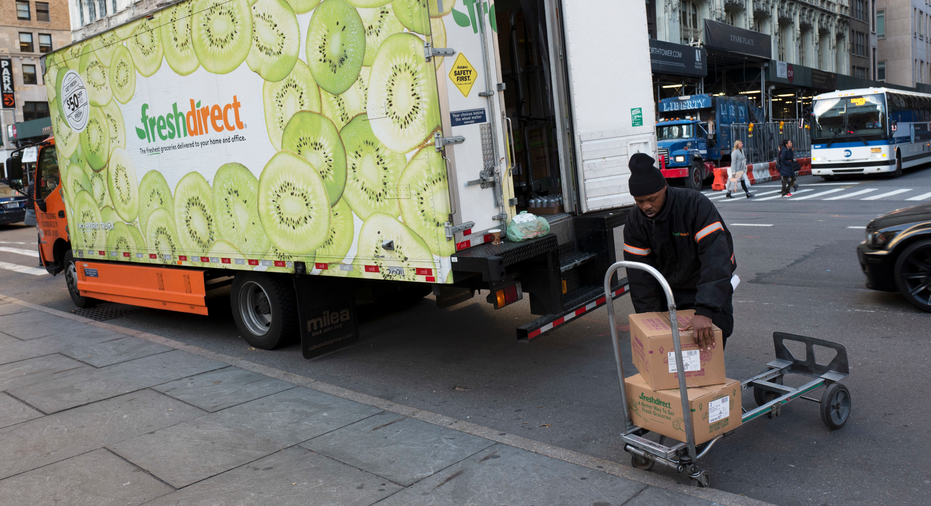On the Money: More grocers are offering delivery
FILE - In this Nov. 27, 2017, file photo a FreshDirect driver loads boxes into his truck in New York. Grocery delivery services are growing rapidly, but shoppers need to decide if the convenience is worth the higher cost. Big companies like Amazon and Walmart are expanding grocery delivery, as are regional players like FreshDirect. (AP Photo/Mark Lennihan, File)
DETROIT – Want to ditch the shopping cart? Grocery delivery services are growing rapidly, but shoppers need to decide if the convenience is worth the higher cost.
Big companies like Amazon and Walmart are expanding grocery delivery, as are regional players like FreshDirect. Grocery chains like Kroger and Safeway are working with third party delivery services like Instacart or developing their own services.
Groceries have been slower to migrate online than books, clothing and other items. Online grocery sales make up 3% of the $800 billion food retail market, according to a recent report by Deutsche Bank. That's expected to climb to 12% by 2025 as services grow and stores offer more options, like online ordering for pickup.
Offerings vary. Customers can pay per delivery or with an annual fee. Orders under $35 generally cost more. Some companies promise delivery in one or two hours. Others, like Peapod, offer next day service. Delivery during peak times may cost more.
Sometimes shoppers pay the same price they would in the store. In other cases, they pay more for each item to cover the processing cost. Shipt says members can expect to pay $5 more per $35 order when they shop through its website versus shopping in a store.
Celeste Haar, a small business owner in Metairie, Louisiana, uses Shipt for orders from Target but Instacart for most groceries. She has a $49 annual membership for Shipt and pays a $9.99 monthly fee for Instacart.
Haar estimates the services save her at least two hours per week.
"This is one small way to take care of myself that is so much better than a massage or pedicure and costs less," she said.
For some, grocery delivery is more than a convenience. Maryjo Harper, a retired insurance claims manager and minister who lives in Wilsonville, Oregon, started using Instacart a little more than a year ago while she was recuperating from rotator cuff surgery.
Harper still uses the service a couple of times a month, especially in the winter. She pays $3.99 per delivery plus service fees. But she's a reluctant user, partly because she feels Instacart isn't transparent about its fees. She recently paid $3.69 on Instacart's website for green leaf lettuce, for example, but on the actual receipt from Safeway — where it was purchased — the lettuce cost $1.19.
There are other downsides to delivery. Customers might miss an interesting new product or a good deal. Picky shoppers might not like what's selected for them. And some customers have complained that delivery drivers won't go to certain neighborhoods.
Still, Tobie Stanger, a senior editor with Consumer Reports, said delivery is a good option for many people.
"There is a cost savings in terms of time, if your time is money," she said.
Customers can save money by ordering online and picking up the groceries themselves, Stanger said. That's already a free option at 2,100 U.S. Walmart stores; 3,100 will have it by the end of this year, the company says. Albertsons Companies, which operates Safeway and other grocery chains, offers online ordering and pickup at 250 stores. At some it's a free option; at others the company charges $3.95 or $4.95 per order.
Here are details on some of the biggest delivery operators:
— Instacart: Founded in 2012, Instacart is now one of the largest grocery delivery services. It has partnerships with 20,000 stores in 5,500 North American cities, including Costco and Aldi. Instacart charges $99 for an annual subscription — or $9.99 monthly — which gives consumers free delivery on orders of $35 or more and lets them shop at warehouse stores like BJ's Wholesale without a membership. Instacart will also deliver from its partner stores to non-members for $3.99 (or $8.99 from member-only warehouse stores) plus a 5% service fee.
— Shipt: Shipt was launched in 2014 and bought by Target Corp. in 2017. It delivers from Target and other grocery stores in 260 cities. An annual plan is $99, although the company was recently offering a Mother's Day special for $49. Membership includes free delivery for orders over $35. Shipt charges $7 for orders under $35.
— Walmart: Walmart offers delivery from 1,000 stores, and plans to expand that to 1,600 by the end of this year. It partners with third party delivery companies like DoorDash. Customers must order at least $30 worth of goods for delivery. They pay the same price they would in store. Walmart charges $7.95 (or $9.95 at higher demand times) to deliver.
— Amazon Prime Now: Prime Now is included in Amazon's $119-per-year Prime membership. In 90 cities, Prime Now will deliver groceries from Whole Foods. Two-hour delivery is free; one-hour delivery is $7.99. There's a $4.99 charge for an order less than $35. In 15 U.S. cities, Amazon also offers AmazonFresh, a grocery delivery service that costs $14.99 per month.
— Peapod: The granddaddy of grocery delivery was founded in 1989 and operates in 24 markets. It requires a minimum order of $60 and charges between $7.95 and $9.95 for delivery. It also offers unlimited free delivery for $119 per year.





















